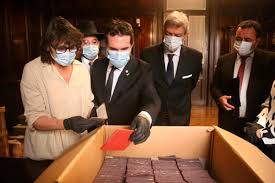
Argentina's Supreme Court Uncovers Nazi Files of ‘Global Significance’ in Basement

 :
| Updated On: 14-May-2025 @ 12:50 pm
:
| Updated On: 14-May-2025 @ 12:50 pmSHARE
In a discovery deemed of "global significance," Argentina’s Supreme Court has uncovered more than 80 boxes filled with documents from Nazi Germany in its basement, more than eight decades after they were first stashed away in 1941. The find occurred as workers cleared the basement in preparation to transfer archives to a newly-established museum. In total, 83 boxes were found, originally sent by the German embassy in Tokyo, Japan, and shipped to Argentina aboard the Japanese steamship Nan-a-Maru in June 1941.
At the time, German diplomats in Argentina claimed the boxes contained personal belongings. However, suspicions arose, and the shipment was intercepted by Argentine customs officials. The crates subsequently became the subject of an investigation by a special commission probing “anti-Argentine activities.” A judge eventually ordered the seizure of the materials, and the matter escalated to the Supreme Court, which assumed control over the crates.
Now, more than 80 years later, the boxes have finally been opened. Inside, the court found materials believed to have been created to consolidate and spread Adolf Hitler’s ideology in Argentina during World War II. The rest of the crates were examined last Friday in the presence of representatives from the Argentine Israelite Mutual Association (AMIA) and officials from the Buenos Aires Holocaust Museum.
This discovery has sparked major historical interest due to its potential to reveal previously unknown details about Nazi activities and propaganda efforts in South America. The documents may also shed light on the scope of Nazi influence and networks operating outside Europe during the war, particularly in Argentina—a country known for its controversial history with former Nazi officials and sympathizers after the war.
The president of Argentina’s Supreme Court, Horacio Rosatti, responded to the discovery by ordering a comprehensive survey and analysis of all the documents. The goal of this investigation is to determine whether the materials hold valuable information about the Holocaust and related events. Rosatti emphasized the importance of assessing whether the files could provide insight into still-unknown aspects of Nazi history, including possible international financial routes used by the regime.
The Argentine judiciary views the find not only as a vital historical breakthrough but also as a significant opportunity for scholars and historians studying World War II and the Holocaust. Given Argentina’s historical connection to post-war Nazi fugitives, the documents could potentially link individuals, ideologies, or money trails to broader global networks that survived or fled Europe after the fall of the Third Reich.
In conclusion, this major archival discovery may offer key revelations about Nazi propaganda in Argentina, hidden international activities during WWII, and perhaps new evidence relating to the Holocaust and Nazi financial operations. The Supreme Court has committed to a thorough examination of the boxes, hoping to contribute crucial knowledge to both national and international historical narratives.